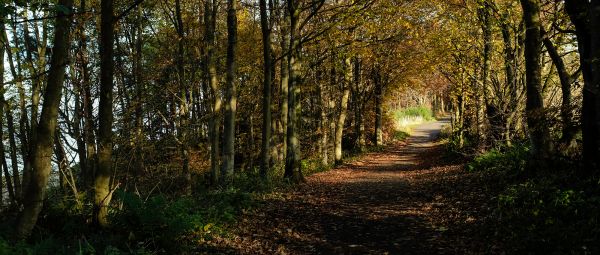Closures and diversions on the rights of way network
Common ways in which public rights of way can change.

Advice relevant to England and Wales only. Find information about access rights in Scotland.
In England and Wales, we enjoy a world-renowned network of public rights of way on which we all have a right to walk. These paths are recorded on a legal document called the Definitive Map and Statement, which is kept and updated by the local highway authority. Changes are made to it when new paths are created, and when existing paths are diverted or removed. Paths are also sometimes temporarily closed or diverted for public safety.
Here are the most common ways in which the public rights of way network can change, whether permanently or temporarily.
Traffic Regulation Orders
A local highway authority (also known as a traffic authority) can make orders under the Road Traffic Regulation Act 1984 to permanently or temporarily prohibit the use of any public path which falls under its authority.
Anyone who uses a path contrary to a Traffic Regulation Order (TRO) is committing an offence and could be liable to a significant fine.
The rights which are shown on the Definitive Map and Statement do not change because of the TRO but they are subject to the restrictions stated in the TRO.
Temporary Traffic Regulation Orders
Under the same legislation a local highway authority also has the power to temporarily close a public path for reasons of public safety. This can be because works are taking place on or near the path, or for other reasons such as an unsafe bridge.
Temporary Traffic Regulation Orders (TTRO) can be made for footpaths, bridleways and byways for up to 6 months initially (18 months for all other highways). If more time is needed, the local authority can apply to the Secretary of State to extend a TTRO. It is possible for footpaths, bridleways and byways to remain closed for years whilst development or repairs are ongoing.
Where possible, the notice advising of the temporary closure should include details of an alternative route. But this is not a legal requirement so sometimes you may have to find your own way of reaching your destination.
Once the TTRO expires, the path should be reopened along the original line. The surface should be repaired to the same standard as it was before the closure (or better).
Permanent Traffic Regulation Orders
The highway authority can also make permanent orders to prohibit use of roads and paths.
These orders are often used to prohibit certain classes of vehicle from using Byways Open to All Traffic. They are also occasionally used to prevent cyclists or horse riders using footpaths to protect walkers or prevent damage to the path.
Special Event Orders
Local authorities use these orders when a road needs to be closed due to a short-term event such as a marathon or a community event. The maximum duration is 3 days. Special Event Orders cannot be made for the same road more than once per year.
Orders to create, divert or extinguish paths
Local authorities have powers to create, divert or extinguish public paths for limited reasons.
These orders permanently change the Definitive Map and Statement.
Diversion orders made by the highway authority
Section 119 of the Highways Act 1980 allows the highway authority (the county council or unitary authority) to make an order to divert a public right of way in the interest of the landowner, the public, or both. An order can only be made if the start and end points of the diverted route are the same as the original route, or if they join to an existing highway connecting to the original route.
The order must be advertised to the public and relevant organisations with a period of consultation of 28 days. During the 28 days, any person can object to the order by writing to the highway authority and stating the grounds of objection.
If the highway authority receives an objection, it cannot confirm the order. It can either abandon the order, or it can submit the order to the Secretary of State who will appoint an inspector to decide whether to confirm it. The Inspector is likely to hold a public inquiry and will undertake at least one site visit.
Before an Inspector can confirm an order made under this section, they must be satisfied that the diversion route is not substantially less convenient than the original route. They must also consider how the diversion would impact the public’s enjoyment of the route.
Therefore, if you want to object to a diversion, focus on how it impacts convenience and enjoyment of the route.
Good objections to raise include:
-
the loss of enjoyable views
-
the diversion route being significantly longer or more challenging
-
the diversion route passing through land likely to flood in winter where it did not before
-
the diversion route requiring walkers to walk on the side of a road with no pavement.
Diversion or extinguishment by the planning authority
Section 257 of the Town and Country Planning Act 1990 allows local planning authorities outside of Greater London (the district council or unitary authority) to make orders to divert or extinguish public rights of way. These orders enable development which would obstruct public paths if it already has planning permission. In these cases a legal order must be made and confirmed to ensure the finished development does not unlawfully obstruct the public path. It is worth noting that a Town and Country Planning Act (TCPA) order is not an opportunity to oppose a development.
If there are objections to a TCPA order then the planning authority must refer the matter to the Secretary of State if it wants to proceed with the order.
In this scenario, for the order to be confirmed, the inspector will assess whether the development can or cannot go ahead without changing the path. If you are looking to safeguard a path that is threatened with extinguishment you are more likely to be successful if you can prove that the path can successfully be diverted via a viable alternative route.
If a completed development is found to have obstructed a path without an order to divert or extinguish it, the planning authority can no longer use a TCPA order. Their only recourse would be to use a highways act order, or to knock down the new development entirely.
The Department for Transport for England, the Welsh Ministers and the local authorities in Greater London can make orders under section 247 of the Town and Country Planning Act 1980 for similar reasons. However, there is no formal consultation period and orders do not need to be confirmed so there is less opportunity to object.
Extinguishment by the highway authority
Under the Highways Act 1980, local highway authorities have the power to permanently close public rights of way if they consider that the path is not needed for public use.
Section 116 can be used to extinguish a path by applying to the magistrates’ court for a closure order. There is no period of public consultation and if the magistrates decide that the legal test is met, the path will be closed without opportunity to comment or object.
Section 118 also allows local authorities to extinguish a public path, following a consultation process and the opportunity to object. The authority cannot confirm an order made under section 118 if there are objections. If objections are raised, it must refer the matter to the Secretary of State if it wants to proceed with the order.
Creation of new paths by the highway authority
The local highway authority can create new footpaths, bridleways and restricted byways using creation agreements under section 25 of the Highways Act 1980 or creation orders under section 26 of the same Act.
Creation agreements are more likely to occur where a landowner wants to dedicate a new path and the council agree the new path is needed. There is no opportunity to formally object to a creation agreement.
Creation orders are more likely where the council believes a new path is needed but may not have support from the landowner. Creation orders must have a period of consultation and opportunity for objection.
Under a creation order the landowner can receive compensation but they will not receive compensation if there is a creation agreement.
Useful Information

Planning applications and rights of way
The Ramblers play an important part in planning applications for developments that affect public rights of way.

Dealing with problems on public paths
The Ramblers guide to reporting problems on public rights of way in England and Wales. Who is responsible, how to contact them and what to expect.

The Definitive Map
The Definitive Map is an important legal record of public rights of way in England and Wales. But how and why did it come to exist?

Claiming unrecorded public rights of way
Unrecorded paths are vulnerable to development and unresolved problems. It is important they are claimed and get the protection they are entitled to.